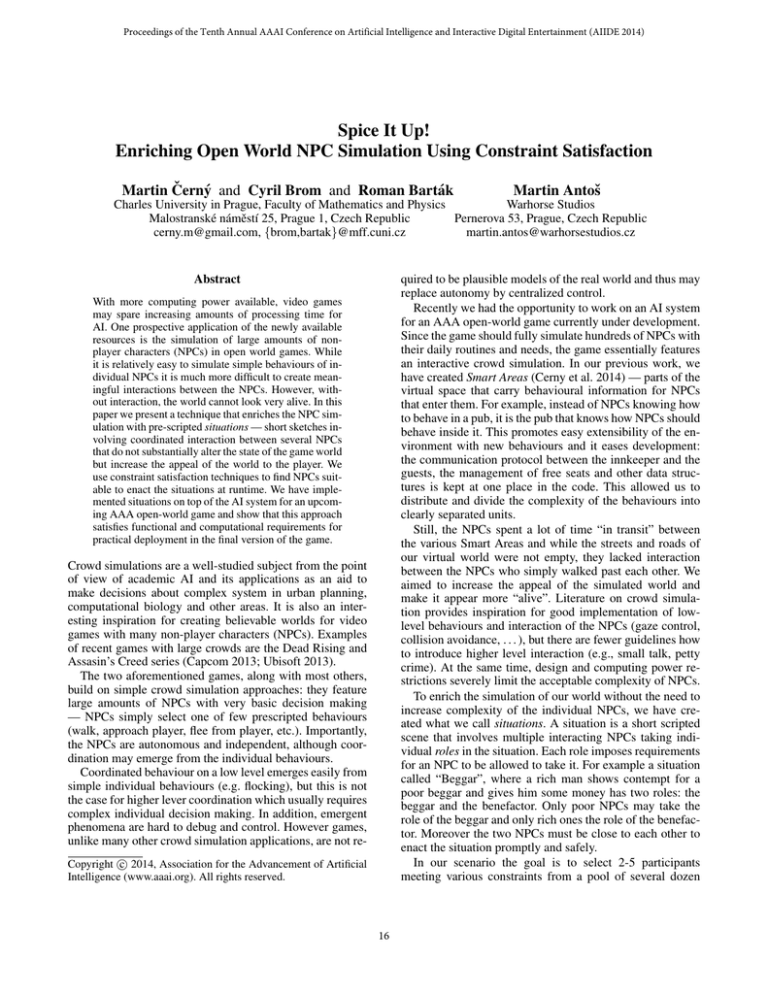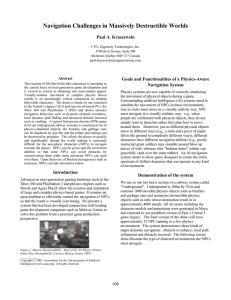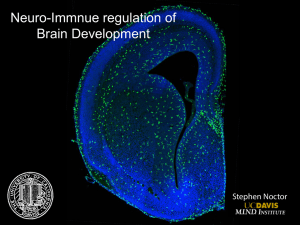
Proceedings of the Tenth Annual AAAI Conference on Artificial Intelligence and Interactive Digital Entertainment (AIIDE 2014)
Spice It Up!
Enriching Open World NPC Simulation Using Constraint Satisfaction
Martin Černý and Cyril Brom and Roman Barták
Martin Antoš
Warhorse Studios
Charles University in Prague, Faculty of Mathematics and Physics
Pernerova 53, Prague, Czech Republic
Malostranské náměstı́ 25, Prague 1, Czech Republic
martin.antos@warhorsestudios.cz
cerny.m@gmail.com, {brom,bartak}@mff.cuni.cz
Abstract
quired to be plausible models of the real world and thus may
replace autonomy by centralized control.
Recently we had the opportunity to work on an AI system
for an AAA open-world game currently under development.
Since the game should fully simulate hundreds of NPCs with
their daily routines and needs, the game essentially features
an interactive crowd simulation. In our previous work, we
have created Smart Areas (Cerny et al. 2014) — parts of the
virtual space that carry behavioural information for NPCs
that enter them. For example, instead of NPCs knowing how
to behave in a pub, it is the pub that knows how NPCs should
behave inside it. This promotes easy extensibility of the environment with new behaviours and it eases development:
the communication protocol between the innkeeper and the
guests, the management of free seats and other data structures is kept at one place in the code. This allowed us to
distribute and divide the complexity of the behaviours into
clearly separated units.
Still, the NPCs spent a lot of time “in transit” between
the various Smart Areas and while the streets and roads of
our virtual world were not empty, they lacked interaction
between the NPCs who simply walked past each other. We
aimed to increase the appeal of the simulated world and
make it appear more “alive”. Literature on crowd simulation provides inspiration for good implementation of lowlevel behaviours and interaction of the NPCs (gaze control,
collision avoidance, . . . ), but there are fewer guidelines how
to introduce higher level interaction (e.g., small talk, petty
crime). At the same time, design and computing power restrictions severely limit the acceptable complexity of NPCs.
To enrich the simulation of our world without the need to
increase complexity of the individual NPCs, we have created what we call situations. A situation is a short scripted
scene that involves multiple interacting NPCs taking individual roles in the situation. Each role imposes requirements
for an NPC to be allowed to take it. For example a situation
called “Beggar”, where a rich man shows contempt for a
poor beggar and gives him some money has two roles: the
beggar and the benefactor. Only poor NPCs may take the
role of the beggar and only rich ones the role of the benefactor. Moreover the two NPCs must be close to each other to
enact the situation promptly and safely.
In our scenario the goal is to select 2-5 participants
meeting various constraints from a pool of several dozen
With more computing power available, video games
may spare increasing amounts of processing time for
AI. One prospective application of the newly available
resources is the simulation of large amounts of nonplayer characters (NPCs) in open world games. While
it is relatively easy to simulate simple behaviours of individual NPCs it is much more difficult to create meaningful interactions between the NPCs. However, without interaction, the world cannot look very alive. In this
paper we present a technique that enriches the NPC simulation with pre-scripted situations — short sketches involving coordinated interaction between several NPCs
that do not substantially alter the state of the game world
but increase the appeal of the world to the player. We
use constraint satisfaction techniques to find NPCs suitable to enact the situations at runtime. We have implemented situations on top of the AI system for an upcoming AAA open-world game and show that this approach
satisfies functional and computational requirements for
practical deployment in the final version of the game.
Crowd simulations are a well-studied subject from the point
of view of academic AI and its applications as an aid to
make decisions about complex system in urban planning,
computational biology and other areas. It is also an interesting inspiration for creating believable worlds for video
games with many non-player characters (NPCs). Examples
of recent games with large crowds are the Dead Rising and
Assasin’s Creed series (Capcom 2013; Ubisoft 2013).
The two aforementioned games, along with most others,
build on simple crowd simulation approaches: they feature
large amounts of NPCs with very basic decision making
— NPCs simply select one of few prescripted behaviours
(walk, approach player, flee from player, etc.). Importantly,
the NPCs are autonomous and independent, although coordination may emerge from the individual behaviours.
Coordinated behaviour on a low level emerges easily from
simple individual behaviours (e.g. flocking), but this is not
the case for higher lever coordination which usually requires
complex individual decision making. In addition, emergent
phenomena are hard to debug and control. However games,
unlike many other crowd simulation applications, are not rec 2014, Association for the Advancement of Artificial
Copyright Intelligence (www.aaai.org). All rights reserved.
16
on simple constraints (Graham 2011). However, tuples of
NPCs are not searched for.
In Hitman: Absolution, AI uses “situations” in a different meaning than we do (Vehkala 2012). Whenever an NPC
deals with an event that requires coordination with other
NPCs (e.g. the player is trespassing and should be stopped),
it subscribes to a corresponding situation object. The situation object maintains a list of subscribed NPCs and internally assigns roles to them (in most cases just “leader”
and “other”). The situation object receives updates from
the game world and alters the knowledge of the subscribed
NPCs (e.g. tells the NPC that it is in a trespassing situation, who is the leader of the situation and how aggressively
should the NPC react). The NPCs than take that knowledge
into account in their own decision making. This way, every
NPC needs to include specific code for every situation it may
participate in. Furthermore, the code for the situation is scattered among multiple NPCs and all variants of the situation
code have to be considered if an NPC needs to coordinate
its behaviour with actions of the other participants. Our approach has the advantage of decoupling situations from the
rest of the AI and it allows for tighter coordination among
NPCs at the cost of fixing the number of NPCs for a situation.
The only CSP application in computer games we are
aware of is in procedural generation of game content. In
(Horswill and Foged 2012) a map in a game is populated
with items and enemies to fulfil various constraints. The paper also reviews other applications of CSP for procedural
content generation.
NPCs, preferably choosing a different solution every time
the search is performed. Due to combinatorial explosion, a
brute-force approach cannot satisfy runtime requirements.
Instead we describe the requirements as a constraint satisfaction problem (CSP) (Dechter 2003) and use CSP solving
algorithms to find suitable NPCs quickly.
In this paper we describe a prototype of our situation system. We report on a case study of several situations we have
implemented to demonstrate the viability of our system for
the game. We discuss qualitative feedback we got from game
designers and scripters and quantitative measurements of
computation requirements of the system.
The rest of the paper is organized as follows: First, related work is reviewed then requirements we had to fulfil are
given, followed by an overview of our system. Then CSPs in
general and our CSP implementation are discussed and we
introduce a case study and quantitative evaluation.
Related Work
(Olivier, Dickinson, and Duckett 2011) discuss the role of
crowds in games, especially in open-world games. They outline a group-based approach to introduce more complex social dynamics to a crowd but they have not implemented it.
The simulation of (Shao and Terzopoulos 2007) features
autonomous pedestrians in a virtual railway station. Several social behaviours (e.g., buying tickets, spectating an art
show) with coordination (e.g., queue at the ticket booth) mediated by specialized environment objects are introduced.
However, characters do not directly interact with each other
and every character must be explicitly prepared for all the
social behaviours it may perform, limiting scalability.
(Pedica and Vilhjálmsson 2010) pioneered the area of
social interactions in virtual crowds. However, their work
focuses on relatively low-level social behaviour (attention,
gaze and positioning) rather than on higher-level behaviours.
In the CAROSA framework (Li and Allbeck 2011) interactions between characters may emerge from agent-centric
decision making. Although little detail is provided, the
main mechanism seems to involve characters switching behaviours in response to their needs and in response to another character with a given need nearby. This way the interaction code has to be split among several parts of the system — the code that triggers the need for interaction, the
code that ensures proper role switching in the other character
once the initiator approaches and the code for the interacting
roles.
Similarly to our approach, (Stocker et al. 2010) introduced “Smart Events” — specific objects providing NPCs
with ready-made responses to external events. An important difference is that Smart Events influence area of the
virtual world and provide behaviours for all types of characters without any explicit coordination among the characters while our situations provide behaviours for carefully selected NPCs and focus on coordination of the NPCs.
Also in other contexts, it has been noted that complex
short-time events are hard to generate and work better when
scripted (Shoulson et al. 2013).
In The Sims: Medieval, there is a central entity that selects
individual NPCs to perform a specific role in the game based
Requirements and Problem Analysis
Since the goal of our situation system is “only” to increase
appeal of the world to the player, it must not interfere with
gameplay-critical mechanics and designers must retain tight
control over it. Further, the situation code should be well encapsulated so that it is possible to develop situations almost
independently of other AI code. The situation code must also
be able to make some assumptions about the NPCs taking
the roles — this is why constraints were introduced.
The downside of this central approach is the necessity to
search for suitable sets of NPCs. Computing time is scarce
in video games, so although situations are scheduled at relatively long intervals (several situations per minute at maximum), an individual search must not take more than 1 ms in
the worst case and the average should be lower than 100 µs.
While our world should feature hundreds of NPCs, there
are multiple considerations that will reduce the number of
NPCs involved in search and thus let us meet the runtime
requirements. Most importantly, situations are, in our case,
only “eye candy” so there is no need to consider NPCs that
are too far from the player and cannot become visible to the
player for the duration of the situation. Next, most of our
situations make sense only in certain areas (e.g., the “Beggar” situation is tied to a city) and thus only NPCs that are
present in the area may be considered. Finally, some of the
NPCs will not be subscribed for situations because they perform a more important behaviour. This way we will never
search more than a few dozen candidate NPCs.
17
System Overview
express the maximal distance between two roles and a unary
constraint may express required NPC properties for a given
role. A solution to a CSP is an instantiation of all the variables satisfying all the constraints.
CSP is NP-complete so the search is exponential in the
worst case, but we expect the search to be relatively “easy”
— situations should be designed in such a way, that most
of the time there are multiple combinations of NPCs that
satisfy the constraints.
The mainstream approach to solve CSPs is based on a
combination of backtracking search and inference. Backtracking search repeatedly selects a variable for instantiation
and then selects a value to be assigned to that variable. After
each variable instantiation, constraints are tested against the
partial solution. If the constraints fail, the search backtracks:
tries another value for the current variable. If there are no
more values for the current variable, the backtrack returns to
the variable assigned previously. The search terminates once
all variables have been instantiated (success) or when there
are no more values to try for the first variable (failure).
Inference techniques reduce search space by propagating
the partial instantiation to other variables. One of the basic
inference techniques is forward checking. It means that values violating any constraint (with the currently instantiated
variables) are removed from domains of not-yet instantiated
variables. For example, if we assign an NPC to a given role
and there is a maximal-distance constraint for another role
then all NPCs that are too far are removed from that role’s
domain. If any domain becomes empty then we backtrack
immediately. Upon backtrack the domains of unassigned
variables are restored to the state prior to the instantiation.
Since unary constraints are independent of assignment of
other variables, values that violate them may be removed
from the domains prior to search. This is called node consistency and it is actually a weaker form of forward checking, where only unary constraints are considered. There are
more advanced inference techniques such as arc consistency
where all the constraints between unassigned variables are
taken into account. Such techniques are useful for hard combinatorial problems, which is not our case.
The situation system is built over our AI system as described
in (Plch et al. 2014) which is deployed in an upcoming AAA
RPG game. The AI system uses an advanced variant of behaviour trees (Champandard 2007) and supports inter-NPC
messaging and seamless behaviour switching.
The central component of the situation system is the situation manager, which decides what situations should be enacted, when they should start and which NPCs should participate. Situation scheduling is driven by designer-specified
minimal and maximal intervals between successive executions. Once a situation is scheduled for execution, the manager searches for suitable NPCs based on constraints associated with the situation. As in the “Beggar” example, there
are unary constraints restricting the holders of individual
roles by various traits of the NPCs (abilities, occupation, social status etc.) and n-ary constraints such as maximal distance between the NPCs or requirement for visual contact
between the NPCs. Furthermore, each NPC keeps track of
situations it has been involved in recently and thus designerspecified intervals between successive executions of situations with the same NPC can be enforced.
To promote designer control and to make sure gameplaycritical behaviours are not interrupted, NPCs must explicitly
subscribe to the situation manager. Once NPCs are given a
role in the situation, they suspend their current behaviour
and are assigned a behaviour specified by the role. This eases
the coordination of the NPCs, because all role holders are
fully controlled by the situation. E.g., in a brawl scenario
participants do not need to negotiate the fighting animations
they should perform and may use explicitly defined shared
semaphore to synchronize the animations.
Transitions between behaviours, including situations, are
managed by the AI system and are detailed in (Plch et al.
2014). If any of the NPCs switches to a higher-priority behaviour (e.g. combat), the behaviour given by the situation
is terminated and after an optional quick cleanup behaviour
the NPC starts the higher priority behaviour. If this happens,
all other role holders in the situation are notified and terminate their behaviours as well. The AI system is responsible
for selecting the behaviour that should be run once the NPC
leaves the situation. In most cases the NPC simply resumes
the behaviour it performed before joining the situation.
The search for NPCs suitable for the situation is modelled
as a constraint satisfaction problem (CSP). Using CSPs has
let us to take benefit of the large amount of previous work
on the topic and quickly implement a solver that meets the
strict runtime requirements of a computer game.
Our CSP Solver
We have implemented two solvers: a backtracking solver for
general use based on the techniques described in previous
section and a local simplified solver for situations featuring
various forms of short interactions between NPCs passing
each other (greeting, waving, etc.). All of those situations
have exactly two roles and are basically reactions to external
stimuli rather than scheduled events. It would be impractical
and wasteful to use a backtracking CSP solver considering
all NPC pairs in this scenario. The solver used for a particular situation is chosen by the designer.
In addition to explicit constraints given by the designers,
an implicit all-different constraint (the same NPC cannot
take more than one role) is encoded in the solver algorithms.
The solvers are implemented in C++.
CSP Overview
A Constraint Satisfaction Problem (CSP) (Dechter 2003)
consists of a finite set of variables, roles in our case, where
each variable has a finite set of possible values, NPCs in
our case, called a domain. The values that can be assigned
to variables are restricted by constraints, where each constraint is defined over a subset of variables and implicitly
defines a subset of the Cartesian product of variables’ domains (allowed tuples). A binary constraint can for example
18
Local Simplified Solver
changed on backtrack and still permanent removal of values
from the domain due to lazy NC was possible in constant
time (copying the last element over the removed element).
We did not implement arc consistency (AC), because it
requires keeping explicit track of pairs of values in unassigned variables. Since NC was already slow and allocating
and updating linear amount of space was troublesome for
FC, it was not likely that working with quadratic amounts of
data could improve performance.
To summarize, we tested five variants of backtracking
solver — plain, with eager NC, with lazy NC, with eager
NC and FC, with lazy NC and FC.
The local solver is run within the update of an NPC’s AI.
It asks the situation manager for a locally searched situation
that is scheduled for execution. If there is such a situation
and if the NPC meets the unary conditions for the first role,
it searches the NPCs with direct visual contact for a suitable
candidate for the second role (the AI system already maintains a visibility list for each NPC for other purposes, so this
is computationally cheap). If no situation is available or no
solution is found a minimal interval is enforced before another search is attempted.
The greetings and similar situations could be as well implemented with a preprogrammed reactive layer in the AI
architecture. But involving the situation system gives more
control to the scripters and thus reduces the workload of programmers. More importantly, describing all of the situations
in a unified way fosters fast development as there is only one
learning curve the scripters need to overcome and programmers have written only single editor support code.
Case Study
The development team includes 6 scripters and 6 designers. All of the scripters have limited programming experience, while designers have close to none. Except for one
scripter with mathematical modelling background, both designers and scripters had no experience in CSP or similar
formalisms. Nevertheless, the idea of situations was relatively clear to both designers and scripters.
The designers found it natural to think in terms of situations, although there was some confusion on the capabilities
of the system and its intended use. Most often, designers
would propose situations that could break if a participant
leaves it due to a higher priority event. To give an example:
“NPC falls into a trapping pit and someone comes to help”
— if the rescuer is disturbed, the NPC is stuck in the pit.
Another frequently mentioned issue was the impossibility to choose and constrain non-NPC game entities as a part
of the search (e.g. find an NPC and a nearby water source
where he could drink). This was left out as future work, once
the system is proven suitable in practice.
To field test the situation system, our design team has proposed several situations that we have implemented:
Backtracking Solver
For most situations we use a CSP solver based on backtracking. The solver is invoked directly by the situation manager
whenever a situation is scheduled and is updated independently of the individual NPCs. Since our CSPs are small, it
did not make sense to implement a sophisticated CSP solver
with complex inference — the overhead would easily cancel out the slight gain in search performance. Instead, we
were adding inference techniques one by one to see, when
the performance stops improving.
We started with the basic backtracking algorithm. Since
variety is important, the solver should not return the same
solution upon repeated execution with the same data (if there
are multiple solutions). Thus the instantiation at each level
starts at a random element of the domain.
Then we added node consistency (NC), i.e. all NPCs
that did not match the unary conditions were removed from
the domains before the search. Surprisingly initial results
showed this approach to be often worse than plain backtracking. Closer analysis revealed that on the smaller domains the time spent in evaluating all the unary constraints
dominated the time in the actual search by factor of two
to ten. Thus we introduced lazy NC evaluation: the unary
constraints are tested only on the values that are actually
searched, but if the condition is not met, the value is removed
from the domain permanently, i.e. it is not reinserted upon
backtrack. While lazy approaches to consistency are known
in the literature (Schiex et al. 1996) we are not aware of any
applications to node consistency.
Last we added forward checking (FC). With a straightforward implementation where contents of domains (arrays of
NPCs) were simply copied prior to instantiation of variables
and restored upon backtrack, the algorithm fared worse than
lazy NC only. An implementation trick was needed to make
the algorithm competitive: Pruned values were not removed
from the domains, but kept at the beginning of the domain
and an internal pointer to the first domain element that was
not pruned was kept. This way, only the pointer needed to be
• Greetings. Various forms of greetings and waving.
• Beggar. A rich NPC passes a beggar and gives him
money. The beggar displays gratitude.
• Payment. A peasant meets a rich man. The rich one demands money to settle a loan. The peasant is reluctant, but
finally pays the requested sum.
• Small talk. Two peasants meet on a corner of the street
and discuss the weather briefly.
• Lively argument. Three peasants meet to argue about
trade, taxes and the heir of the throne.
• Dance. A musician starts playing music on the street.
Four peasants gather around and perform a group dance.
• Difficult. A non-natural representation of the “Dance” situation to test a slightly more extreme scenario.
Formally, all of the situations have constraints on
the occupation/social class of the participants, and distance/visibility constraints among all pairs of the participants. The “Difficult” situation is an exception as only 4
pairs of NPCs are affected by binary distance constraints.
Still the constraint graph is connected and thus there are implicit “transitive” distance constraints over all NPC pairs, but
19
Backtracking Solver
those implicit constraints are inaccessible to the search algorithm and violations of those constraints are discovered only
after assigning NPCs to the “intermediary” roles.
The “Greetings” situation is the only one using the local
solver. The “Small talk”, “Lively argument” and “Dance”
also require all NPCs to be close to one of designer-marked
areas suitable for situation enactment. “Payment” has a special condition for the peasant to check whether it makes
sense for him to pay a loan. This condition is expressed as
a Lua (Ierusalimschy, De Figueiredo, and Celes Filho 1996)
script and we expect it to be very costly to call. Except for
“Greetings” which is available everywhere, all other situations are tied to a city.
Describing situations in terms of conditions on role holders was a straightforward idea for the scripters, but they had
some difficulty to decide what should be modelled by unary
constraints and what should be a n-ary constraint. For example, in the “Beggar” situation, the first idea was to not
constrain the richness of the benefactor in a unary condition, but create a binary condition “benefactor richer than
beggar”, which would likely result in longer search times.
Table 1 shows the ratio of successful searches in both scenarios. Since all the search was never interrupted prematurely,
failed searches represent problem instances that had no solution. The table shows that we tested both situations that
always had a solution and those where solutions were rare
and those in between, although the number of solvable assignments grew with more NPCs available.
Situation
Beggar
Payment
S. Talk
Argument
Dance
Complicated
215
101
98
56
24
45
2
116
123
161
187
166
99%
47%
44%
26%
11%
21%
222
0 100%
205 25 89%
157 69 69%
172 52 77%
93 134 41%
168 60 74%
Table 1: No. of successful (Suc.) and failed (F.) searches.
The timing results are given in Table 2. The most important finding is that LazyNC performed the best for all situations in Scenario 1 and safely fulfilled the required time
limits (recall the requirements: 100 µs on average and 1 ms
in the worst case). The problem instances are just too small
for FC to make a difference, although the LazyNC-FC variant fulfils the time limits as well. Solving “Payment” takes
a remarkably long time, because it involves execution of a
script to evaluate a unary constraint which is costly. Script
constraints are discouraged for production use and should
serve as a prototyping tool only. Still LazyNC and LazyNCFC stayed within performance bounds.
In Scenario 2 LazyNC still performs very well for all the
2-NPC situations. This is not surprising, as FC needs to scan
the whole domain of the second NPC with every assignment
of the first NPC during inference and then scans the remaining values again during search while LazyNC visits all the
domain values at most once. In this regard it is unexpected
that LazyNC-FC is better in the “Small Talk” situation. The
reason is probably that the binary distance constraint is faster
to evaluate than the unary constraint that checks whether the
NPC is close to a suitable area, which is worst-case linear in
the number of nearby areas (up to 5 in our scenarios). Some
optimization of this condition might be useful.
The FC technique performs better also at the 3-NPC “Argument” and 5-NPC “Dance” where finally the domains are
large enough for pruning to have notable effect. In contrast
with Scenario 1, “Complicated” became much faster to solve
than the “Dance” situation on average. This is most likely
due to the fact that in Scenario 2, “Complicated” had solutions much more often than “Dance” and successful searches
were generally much faster than failed ones.
Combination of LazyNC for 2-NPC situations and
LazyNC-FC for multiple NPCs situations satisfies the runtime constraints even upon heavy load, except for the
“Dance” situation and “Payment” (which takes long due
to the scripted constraint). If the “Dance” situation is not
Quantitative Results
We created two scenarios. Scenario 1 models the expected
workload and involves 50 NPCs: 2 musicians, 6 rich, 8 beggars and 34 peasants. The NPCs moved around the game
world, sometimes performing a non-interruptible behaviour;
in effect 28 NPCs were registered for situations in an average search task (standard deviation: 4.7, max: 49, min:
14) Scenario 2 tests a heavier, unrealistic load to check the
scalability of the system. It involves a larger world and 300
NPCs, divided in the same proportions as in Scenario 1, with
193 registered for situations on average (standard deviation:
24, max: 270, min: 149). Tests were run on an Intel i5-3470
quad core processor @3.2 GHz, with 8GB RAM. To reduce
measurement noise, the backtracking solver was run synchronously with the game engine and the engine was forced
into single-threaded execution for the purpose of the test.
Both scenarios were run until at least 200 instances of all
globally scheduled situations were executed. During the experiment all situations were run with the same frequency.
All five backtracking solver variants solved exactly the same
CSP instances1 .
Local Solver
The local solver (used for the “Greetings” situation) is hard
to measure precisely as the individual executions are very
quick and thus the measurement itself skews the results significantly. It is however safe to say that even in Scenario
2 the individual executions were faster than 1 µs. Since the
solver does not need to be run frequently (a 1 Hz tick is still
acceptable) it means that it is safe to execute the local solver
within the AI updates. Thanks to the distributed nature of
the local solver the AI system has tight control over the time
allocated to solving — if time is running out, local solving
may be skipped or postponed to next frame for some NPCs
and the system will degrade gracefully.
1
Scenario 1
Scenario 2
Suc.
F.
% Suc.
F.
%
The full dataset is available at http://bit.ly/1mmGBks
20
Scenario 1 - 50 NPCs, ∼28 registered
Beggar
S. Talk
Avg (sd) Max Avg (sd) Max
Back
NC
LazyNC
NC-FC
LazyNC-FC
5 (10)
16 (04)
3 (02)
27 (05)
15 (02)
125
34
12
47
33
18 (10)
19 (05)
14 (07)
29 (07)
25 (05)
60
43
39
61
36
Payment
Avg (sd) Max
95 (52)
117 (27)
87 (42)
161 (37)
92 (41)
331
258
205
329
248
Argument
Avg (sd) Max
30 (22)
27 (09)
20 (09)
38 (10)
36 (08)
123
55
60
81
60
Dance
Avg (sd) Max
22 (25)
22 (19)
17 (11)
35 (21)
42 (08)
154
79
55
110
80
Complicated
Avg (sd) Max
245 (618)
38 (11)
21 (08)
51 (12)
55 (12)
4869
82
53
92
93
Scenario 2 - 300 NPCs, ∼193 registered
Beggar
S. Talk
Avg (sd) Max Avg (sd) Max
Back
6 (03)
NC
130 (18)
LazyNC
4 (03)
NC-FC
164 (26)
LazyNC-FC 31 (04)
19 95 (92)
208 158 (20)
16 69 (45)
408 196 (27)
54 52 (29)
Payment
Avg (sd) Max
594 539 (396)
232 875 (173)
183 466 (335)
286 1104 (208)
171 482 (359)
Argument
Avg (sd) Max
Dance
Avg (sd) Max
Complicated
Avg (sd) Max
1816 213 (242) 1239 435 (700) 5557 14ms (38ms) 273ms
1702 235 (37) 415 306 (149) 584
366 (66)
584
1586 119 (73) 366 179 (124) 600
89 (38)
246
1958 271 (41) 423 345 (155) 686
408 (66)
577
1579
96 (59) 305 149 (067) 462
136 (66)
326
Table 2: Aggregate results for search time for individual situations and algorithms. The average (Avg) times, standard deviation
(sd) and maximum (Max) are given. Best results in each column are in boldface. Unless explicitly stated, times are in µs.
scheduled frequently, the system as a whole would be fast
enough.
Notably, the search for NPCs is on the same time scale
as pathfinding — instances in Scenario 1 are comparable to
finding shorter paths and those in Scenario 2 are comparable
to finding paths across large parts of the game world.
Further analysing the successful and failed runs separately
shows some deviations from the average case, but the overall picture remains the same. In general, plain backtracking
ranks better in successful runs than on average, but is much
worse in failed runs, while eager NC and NC-FC ranks better in unsuccessful ones than on average. This is most likely
an intrinsic property of the algorithms: If there are many solutions, backtracking is likely to find one and it avoids the
overhead of the other algorithms. Eager NC on the other
hand is a pessimistic technique which fails quickly if there
are no or very few values satisfying the unary constraints.
offline and online procedural content generation. Instantiating side quest templates or detecting important abstract
game events might be among the interesting future applications. CSP also maintains a high level of designer control
— undesirable solutions are easy to remove by adding new
constraints. We hope that this example will promote the use
of CSPs in games, as even simple and fast-to-implement algorithms have satisfactory performance.
Future work includes extending the situation system to
search for items, locations and other non-NPC entities in the
game world as part of the situation search. Another possibility is to introduce “passive” and “optional” roles. Passive
NPCs are constrained in the search, but do not receive behaviour; they serve as a target of actions only (e.g. a situation where an NPC comments on another NPCs work).
Optional roles on the other hand receive behaviours, but the
search may be successful, even when no NPCs are found
for the role. The situation system should also be evaluated
by humans to make sure that situations actually increase the
appeal of the game world to players.
Discussion and Future Work
We have introduced a system for enriching a simulated
world with short pre-scripted situations. Our algorithm uses
CSP to search for appropriate NPCs and to decouple the situations from the rest of the AI code. We have shown that
the system meets functional and runtime requirements of a
commercial game. The system is currently being evaluated
for production use in an upcoming AAA RPG game and the
initial response from scripters and designers was positive.
In recent years the advances in hardware allowed classical AI techniques such as planning to become part of mainstream game AI. We show that CSP may as well follow. In
our view application areas of CSPs in games are open: CSP
makes it possible to decouple various parts of the game and
find appropriate connections (NPCs to situation role in our
case) at runtime. It also has numerous applications in both
Acknowledgements
This research is supported by the Czech Science Foundation under the contract P103/10/1287 (GACR), by student
grant GA UK No. 559813/2013/A-INF/MFF and partially
supported by SVV project number 260 104.
Special thanks belong to Warhorse studios and its director Martin Klı́ma for making this research possible by their
openness to novel approaches and by letting researchers
work in close cooperation with the company. Thanks also to
Tomáš Plch, Petr Ondráček and Matěj Marko for their work
on the underlying AI system and ongoing support.
21
References
Vehkala, M.
2012.
Crowds in hitman: Absolution. AIGameDev.com. http://aigamedev.com/ultimate/
video/hitmancrowds/ Last checked 2014-08-07.
Capcom. 2013. Dead Rising 3. http://www.xbox.com/enUS/xbox-one/games/dead-rising-3. Last checked: 2014-0511.
Cerny, M.; Plch, T.; Marko, M.; Ondracek, P.; and Brom,
C. 2014. Smart areas: A modular approach to simulation
of daily life in an open world video game. In Proceedings
of the 6th International Conference on Agents and Artificial
Intelligence, 703–708.
Champandard, A. 2007. Understanding behavior trees.
AIGameDev.com.
http://aigamedev.com/open/article/btoverview/ Last checked 2014-01-05.
Dechter, R. 2003. Constraint Processing. Morgan Kaufmann Publishers.
Graham, D. 2011. AI development postmortems: Inside
The Sims: Medieval. In Game Developers Conference 2011.
http://bit.ly/1qMNsYL Last checked: 2014-07-18.
Horswill, I. D., and Foged, L. 2012. Fast procedural level
population with playability constraints. In Proceedings of
The Eighth Annual AAAI Conference on Artificial Intelligence and Interactive Digital Entertainment, 20–25.
Ierusalimschy, R.; De Figueiredo, L. H.; and Celes Filho,
W. 1996. Lua - an extensible extension language. Software:
Practice & Experience 26(6):635–652.
Li, W., and Allbeck, J. M. 2011. Populations with purpose.
In Proceedings of Motion in Games, 133–144. Springer.
LNCS 7060.
Olivier, S.; Dickinson, P.; and Duckett, T. 2011. From individual characters to large crowds: Augmenting the believability of open-world games through exploring social emotion in pedestrian groups. In Proceedings of DiGRA 2011
Conference: Think Design Play.
Pedica, C., and Vilhjálmsson, H. H. 2010. Spontaneous
avatar behavior for human territoriality. Applied Artificial
Intelligence 24(6):575–593.
Plch, T.; Marko, M.; Ondracek, P.; Cerny, M.; Gemrot, J.;
and Brom, C. 2014. An AI system for large open virtual
world. In Proceedings of Tenth Annual AAAI Conference on
Artificial Intelligence and Interactive Digital Entertainment.
This proceedings.
Schiex, T.; Régin, J.-C.; Gaspin, C.; and Verfaillie, G. 1996.
Lazy arc consistency. In AAAI/IAAI, Vol. 1, 216–221.
Shao, W., and Terzopoulos, D. 2007. Autonomous pedestrians. Graphical models 69(5):246–274.
Shoulson, A.; Gilbert, M. L.; Kapadia, M.; and Badler, N. I.
2013. An event-centric planning approach for dynamic realtime narrative. In Proceedings of the 6th International Conference on Motion in Games, 99–108. ACM.
Stocker, C.; Sun, L.; Huang, P.; Qin, W.; Allbeck, J. M.; and
Badler, N. I. 2010. Smart events and primed agents. In
10th International Conference on Intelligent Virtual Agents,
15–27. Springer. LNCS 6356.
Ubisoft. 2013. Assasin’s Creed IV: Black Flag. http:
//assassinscreed.ubi.com. Last checked: 2014-08-07.
22






